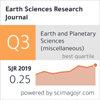Susceptibility to erosion risks in soils dedicated to the pineapple cultivation in the state of Valle del Cauca, Colombia
IF 0.7
4区 地球科学
Q4 GEOSCIENCES, MULTIDISCIPLINARY
引用次数: 0
Abstract
In Colombia almost half of the soils are prone to erosion, where Valle del Cauca is one of the most affected departments with respect to its severity. In order to identify the susceptibility to erosion risks in terms of the rainfall erosivity and the incidence of the topographic factor in the main pineapple producing municipalities of the department, a study was carried out that contemplated the historical climatological information of more than 50 years, for which all available weather stations in the area were selected. The erosivity index (R–EI30), the modified Fournier index (MFI), and the topographic factor (LS) were estimated. The results indicate that the average MFI values ranged between (91.31 and 582.79) which correspond to the moderate, high and very high categories, the results of R-EI30 presented moderate, high, very high and extremely severe values (5076.91 MJ.mm.ha-1 - 22718.83 MJ.mm.ha-1), while the highest values of the topographic factor (with slopes up to 81°) coincide with the upper part of the river basin Dagua, predominantly in the municipality of Dagua. These values indicate that the soils in the area are susceptible to erosion risks depending on the rainfall erosivity and the topographic factor at a moderate, high and very high level, which can generate significant soil losses, and therefore they should be considered when establishing a pineapple crop.哥伦比亚考卡山谷种植菠萝的土壤易受侵蚀风险
在哥伦比亚,几乎一半的土壤容易受到侵蚀,考卡山谷是受侵蚀最严重的地区之一。为了确定该部门主要菠萝生产城市的降雨侵蚀力和地形因素的发生率对侵蚀风险的敏感性,进行了一项研究,考虑了50多年的历史气候信息,并选择了该地区所有可用的气象站。对侵蚀力指数(R–EI30)、修正的福尼尔指数(MFI)和地形因子(LS)进行了估算。结果表明,平均MFI值在(91.31至582.79)之间,对应于中等、高和极高类别,R-EI30的结果呈现中等、高、极高和极高值(5076.91 MJ.mm.ha-1至22718.83 MJ.mm.ha-1),而地形因子的最高值(斜率高达81°)与Dagua河流域的上部一致,主要在Dagua市。这些数值表明,该地区的土壤容易受到侵蚀风险的影响,这取决于中等、高和极高水平的降雨侵蚀力和地形因素,这可能会造成严重的土壤损失,因此在种植菠萝作物时应考虑这些因素。
本文章由计算机程序翻译,如有差异,请以英文原文为准。
求助全文
约1分钟内获得全文
求助全文
来源期刊

Earth Sciences Research Journal
地学-地球科学综合
CiteScore
1.50
自引率
0.00%
发文量
0
审稿时长
>12 weeks
期刊介绍:
ESRJ publishes the results from technical and scientific research on various disciplines of Earth Sciences and its interactions with several engineering applications.
Works will only be considered if not previously published anywhere else. Manuscripts must contain information derived from scientific research projects or technical developments. The ideas expressed by publishing in ESRJ are the sole responsibility of the authors.
We gladly consider manuscripts in the following subject areas:
-Geophysics: Seismology, Seismic Prospecting, Gravimetric, Magnetic and Electrical methods.
-Geology: Volcanology, Tectonics, Neotectonics, Geomorphology, Geochemistry, Geothermal Energy, ---Glaciology, Ore Geology, Environmental Geology, Geological Hazards.
-Geodesy: Geodynamics, GPS measurements applied to geological and geophysical problems.
-Basic Sciences and Computer Science applied to Geology and Geophysics.
-Meteorology and Atmospheric Sciences.
-Oceanography.
-Planetary Sciences.
-Engineering: Earthquake Engineering and Seismology Engineering, Geological Engineering, Geotechnics.
 求助内容:
求助内容: 应助结果提醒方式:
应助结果提醒方式:


